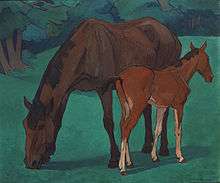Camden Town Group
The Camden Town Group was a group of English Post-Impressionist artists active 1911-1913. They gathered frequently at the studio of painter Walter Sickert in the Camden Town area of London.
History
In 1908, critic Frank Rutter created the Allied Artists Association (AAA), a group separate from the Royal Academy artistic societies and modelled on the French Salon des Indépendants. Many of the artists who became the Camden Town Group exhibited with the AAA.

The members of the Camden Town Group included Walter Sickert, Harold Gilman, Spencer Frederick Gore, Lucien Pissarro (the son of French Impressionist painter Camille Pissarro), Wyndham Lewis, Walter Bayes, J.B. Manson, Robert Bevan, Augustus John, Henry Lamb, Charles Ginner, and John Doman Turner.
Influences include Vincent van Gogh and Paul Gauguin whose work can clearly be traced throughout this groups work. Their portrayal of much of London before and during World War I is historically interesting and artistically important.[1]

In the Cinema by Malcolm Drummond is noted for its claustrophobic feeling. It is an interesting foil to the work of Sickert who painted many rowdy music hall scenes, including Gallery of the Old Mogul (also depicting the viewers of a film). Sickert's "Ennui" of 1914 is often considered the masterpiece of this group's work, with its portrayal of boredom and apathy in the mould of Flaubert and others.
The group organized the exhibition of Cubist and Post-Impressionist paintings.
A major retrospective of the group's works was held at Tate Britain in London in 2008. The show did not include eight of the members, among them Duncan Grant, J.D. Innes, Augustus John, Henry Lamb, Wyndham Lewis and J.B. Manson, who was, according to Wendy Baron, of "too little individual character".[2]
Members

It was decided that there should be a 16-member, men only, limit on the group: Maxwell Gordon Lightfoot died after the first exhibition, and Duncan Grant was elected to take his place.[3]
- Walter Bayes
- Robert Bevan
- Malcolm Drummond
- Harold Gilman
- Charles Ginner
- Spencer Frederick Gore
- Duncan Grant
- James Dickson Innes
- Augustus John
- Henry Lamb
- Wyndham Lewis
- Maxwell Gordon Lightfoot
- J.B. Manson
- Lucien Pissarro
- William Ratcliffe
- Walter Sickert
- John Doman Turner
Although women were excluded from the Camden Town Group, a few women artists like Ethel Sands, Anna Hope Hudson and Marjorie Sherlock were involved on the periphery, yet others like Sylvia Gosse and Nan Hudson were cut out altogether.[4]
See also
Notes and references
- ↑ Spalding, Dictionary of British Art, vol.VI, p.19-22
- ↑ Lambirth, Andrew (5 March 2008). "Velvet revolutionaries". The Spectator. Retrieved 13 March 2016.
- ↑ Baron, Wendy and Sickert, Walter. Sickert: Paintings and Drawings, p. 81, Yale University Press, 2006. ISBN 0-300-11129-0, ISBN 978-0-300-11129-3. Available on Google books.
- ↑ Ian Chilvers, A Dictionary of Twentieth-Century Art (Oxford: Oxford University Press, 1999), 110. It was accessed via Questia, a subscription required site.
Further reading
- Wendy Baron, Perfect Moderns: A History of the Camden Town Group, Ashgate, 2000 ISBN 978-1840142914
- Robert Upstone, Modern Painters: The Camden Town Group, exhibition catalogue, Tate Britain, London, 2008 ISBN 1-85437-781-7
- Helena Bonett, Ysanne Holt, Jennifer Mundy (eds.), The Camden Town Group in Context, Tate, May 2012, http://www.tate.org.uk/art/research-publications/camden-town-group
